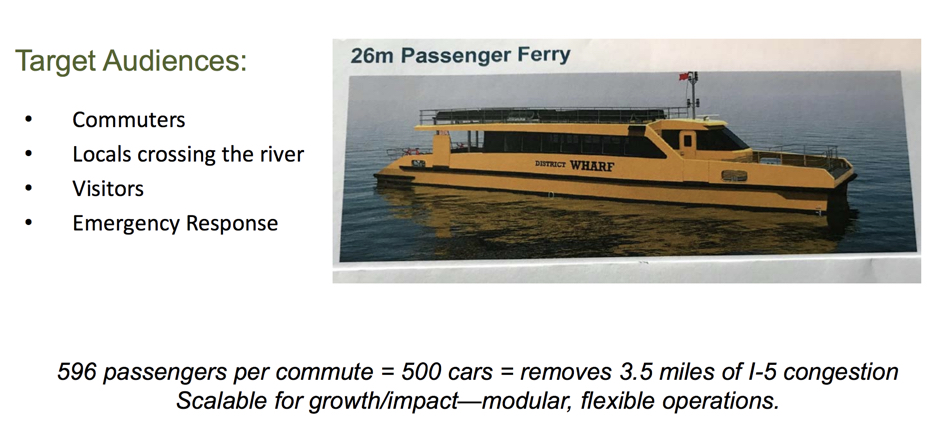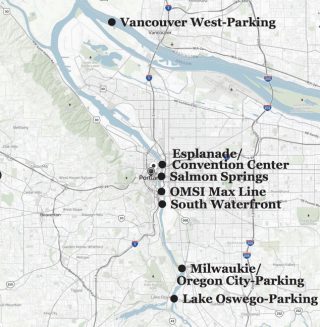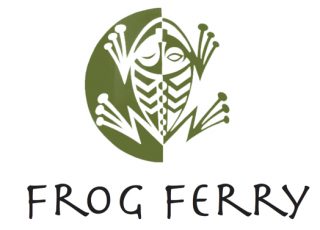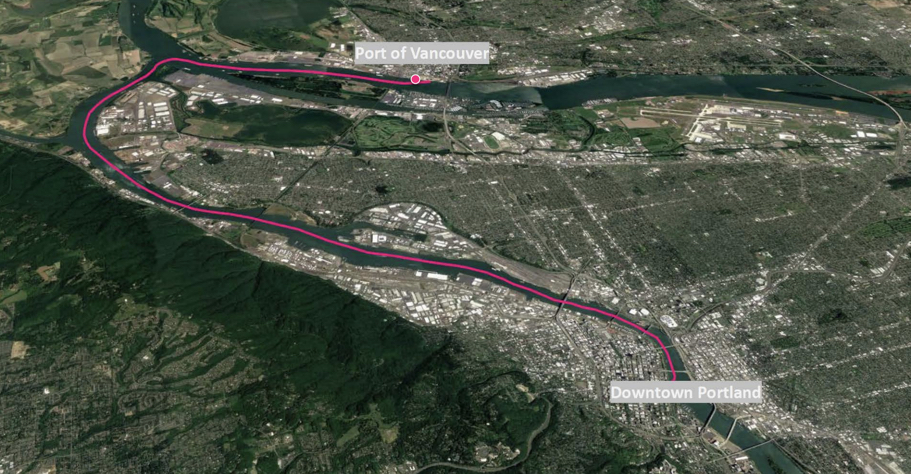
The ‘Frog Ferry’ has taken a major leap forward this week. The passenger ferry concept is making its first major public debut with media coverage and a spot on the agenda at today’s meeting of the Oregon Transportation Commission (the governor-appointed body that sets transportation policy for the State of Oregon).
Spearheading the effort is Susan Bladholm, a former director of Cycle Oregon and corporate marketing professional who spent 10 years each with Business Oregon and the Port of Portland. Bladholm has spent two years researching and building support for her plan to establish a ferry service on the Willamette River that would shuttle customers between Lake Oswego and Vancouver.
Flanked by Portland Spirit Owner Dan Yates and Metro Project Manager Chris Ford (fresh of his win as project manager for the SW Corridor, which was approved by Metro Council last night), Bladholm said, “It’s time for a new mode of transportation to be introduced.”


“The heavy lift is bringing in the infrastructure and changing the culture,” she continued. “Just like cycling. Now we have cyclists all over the place; but way back when our shoulders weren’t all that wide or very clean, and we didn’t have cyclists. Infrastructure was needed.”
Far from just a pie-in-the-sky idea, Bladholm (whose bio says, “she has staffed five governors”) can boast of having 450 supporters lined up behind her. She’s met with dozens of agency staff and was personally introduced to ODOT management by Director Matt Garrett. The Frog Ferry has support from major power brokers in Portland politics and river interests including the Port of Portland, Port of Vancouver, Zidell Companies, Working Waterfront Coalition, Vigor Industrial, Travel Oregon, City of Portland (Mayor Ted Wheeler), Portland Business Alliance, Central Eastside Industrial Council, and Daimler Trucks North America.
Advertisement

Metro likes the idea too. Ford told commissioners today that, “We’re encouraged to see the private sector exploring climate-friendly transportation options that recognize a sense of place.” (The
“Frog” part of the name is based on Chinook mythology.) Ford said the 2018 Metro Regional Transportation Plan includes the ferry concept, which gives it, “A hall pass for further study.”
The idea of a water ferry was also the subject of a 2006 City of Portland study as part of the River Renaissance initiative. One key barrier cited back then was the lack of terminals and dock facilities and the high cost to built them. That’s why strong private sector interest makes the Frog Ferry concept different.
According to Frog Ferry documents, the concept would include seven stops between Vancouver and Lake Oswego, with future plans that could add more stops and extend the service to Camas, Troutdale, and St. Helens. The service would target commuters, errand-runners, tourists, and people in emergencies. “When and if the big earthquake happens we’ll have more vessels to move people around when all the bridges come crumbling down,” Yates said today.
Estimates of use and trip times are still approximate, but a presentation shows the trip between Rose Quarter and Vancouver taking 25 minutes. Lake Oswego to Vancouver would be 41 minutes. To drive the 20 miles between Lake Oswego or the Rose Quarter to Vancouver would take around an hour or 30 minutes respectively during typical commute traffic.
The ferries themselves would fit about 149 people and would have room for bikes. Bladholm told the OTC today that that equates to taking 500 cars off the roads, based on Columbia River Crossing project research that found 67% of I-5 auto traffic that crosses the Columbia River is single-occupancy.
To further understand the costs and benefits of the project, Frog Ferry backers are asking the State of Oregon to help fund a $650,000 feasibility study.

“Rather than saying it’s too hard or too expensive,” Bladholm said today, “let’s be informed. let’s be curious, rather than say we simply can’t do it.” And Portland Spirit owner Dan Yates put it bluntly after expressing his dislike of government delays and regulations. “I’m willing to buy the first boat, but you guys have to do the study.”
Yates added that he envisions a system of 16 electric ferries that would ideally be have to be tightly integrated into the TriMet and Streetcar systems.
When commissioners had a chance to respond, OTC Chair Tammy Baney said, “I am floored by the passion behind it.”
Commissioner Alando Simpson also expressed support of the project, saying, “I think it’s a very realistic and practical concept.” Simpson also said he was concerned he didn’t see any representation from environmental justice advocates in Frog Ferry documents. “You’re going to have to figure out how you tap into those constituent bases,” he advised.
Frog Ferry’s timeline says they want to launch in 2020. That doesn’t seem likely, but I wouldn’t doubt Bladholm. She has the experience, skills, and connections to make this work. “We’re doing our part,” she told the OTC this morning, “Now we’re asking agencies to step up and help us.”
Learn more at FrogFerry.com.
— Jonathan Maus: (503) 706-8804, @jonathan_maus on Twitter and jonathan@bikeportland.org
Never miss a story. Sign-up for the daily BP Headlines email.
BikePortland needs your support.

